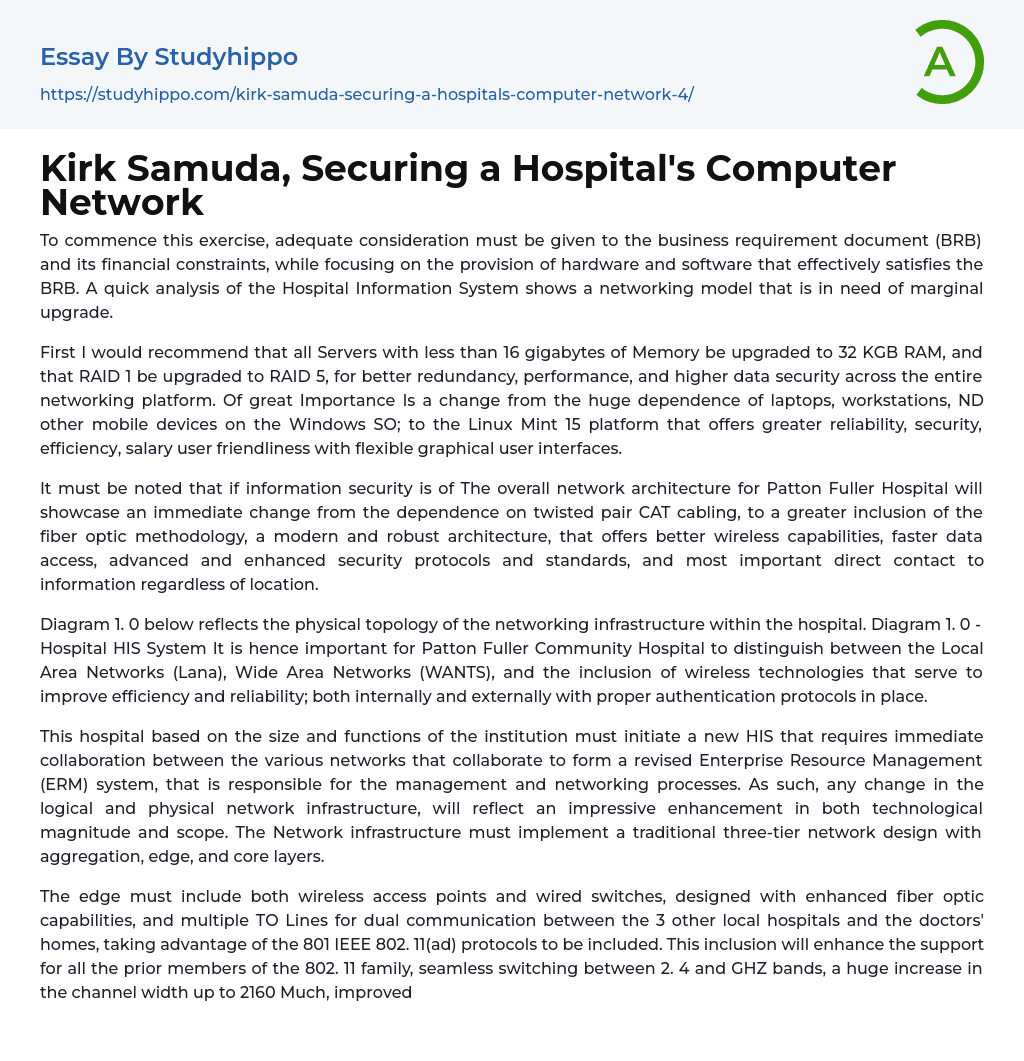

Kirk Samuda, Securing a Hospital’s Computer Network Essay Example
In order to start this exercise, it is important to take into account the business requirement document (BRB) and its financial restrictions. The main goal is to provide hardware and software that can effectively meet the requirements of the BRB. A brief examination of the Hospital Information System reveals that there is a need for a minor upgrade to the networking model.
I propose upgrading all Servers with less than 16 gigabytes of Memory to 32 KGB RAM and upgrading RAID 1 to RAID 5. These upgrades will enhance redundancy, performance, and data security throughout the networking platform. It is crucial to reduce reliance on Windows OS for laptops, workstations, and other mobile devices. Instead, consider transitioning to the Linux Mint 15 platform that provides superior reliability, security, efficiency, and user friendliness through flexible graphical user interfaces.
The overall network architecture for
...Patton Fuller Hospital will undergo a significant transformation in terms of information security, shifting from twisted pair CAT cabling to a more extensive use of fiber optic methodology. This modern and robust architecture provides improved wireless capabilities, faster data access, advanced security protocols and standards, and most importantly, enables direct access to information from any location.
Diagram 1. 0 below shows the physical topology of the networking infrastructure in the hospital, specifically the Hospital HIS System. It is crucial for Patton Fuller Community Hospital to differentiate between the Local Area Networks (LAN), Wide Area Networks (WAN), and the integration of wireless technologies that enhance efficiency and reliability. This applies to both internal and external networks, ensuring proper authentication protocols are implemented.
This hospital needs to implement a new HIS that requires collaboration
among various networks to form a revised ERM system. This system manages and networks processes. Any changes in the network infrastructure will greatly improve the technology and scope. The network infrastructure should use a traditional three-tier network design with aggregation, edge, and core layers.
The edge should consist of wireless access points and wired switches that are designed with enhanced fiber optic capabilities and multiple TO Lines for dual communication. This will enable communication between the 3 other local hospitals and the doctors' homes. The edge will take advantage of the 801 IEEE 802.11(ad) protocols to improve support for all previous members of the 802.11 family. It will allow seamless switching between 2.4 and GHz bands, provide a significant increase in channel width up to 2160 MHz, enhance mobile device functionality, extend working range, and offer advanced security features.
The growing number of workstations, laptops, mobile devices, monitoring equipment, phones, imaging modalities, and other hospital devices at the network edge will be accommodated by a three-tier network architecture. Strict authentication policies will allow these devices to access the hospital's central network via an aggregation layer that connects the network edge to the network core. To ensure effective ERM, it is crucial to build the Local Area Networks (LANA) in each department of the hospital using the star topology, which provides the fastest data transmission rates for 1000 Base T.
Let's understand that each LANA will connect devices or workstations within a short distance using TCP/IP with a subnet 'P, using Ethernet connectivity technology. Lana will have both a LANA address and a WAN address. Including wireless technology in the networking scope is crucial for Patton
Fuller Hospital to expand its networking capabilities for services such as PIPIT, HDTV, voice-over-IP (POI), and Multimedia broadband applications.
The Wireless Internet Fiber Router (WIFE), FRR-Exxon series, created by www.Planet.com, utilizes 802.11 n and TRY IMO antenna technology. This router offers office and residential users an optimal solution for sharing a high-speed fiber Internet connection and a Fast Ethernet backbone with four 10/Mbps ports. The FRR-Exxon series serves as an ideal digital router for accessing the Internet at high performance levels, both upstream and downstream up to mobcaps, through the fiber interface.
- Computer File essays
- Desktop Computer essays
- Servers essays
- Networking essays
- Telecommunication essays
- Network Topology essays
- Telecommunications essays
- Camera essays
- Cell Phones essays
- Computer essays
- Ipod essays
- Smartphone essays
- Android essays
- Application Software essays
- Benchmark essays
- Computer Network essays
- Computer Programming essays
- Computer Security essays
- Computer Software essays
- Cryptography essays
- Data collection essays
- Data Mining essays
- Graphic Design essays
- Information Systems essays
- Internet essays
- Network Security essays
- Website essays
- World Wide Web essays



